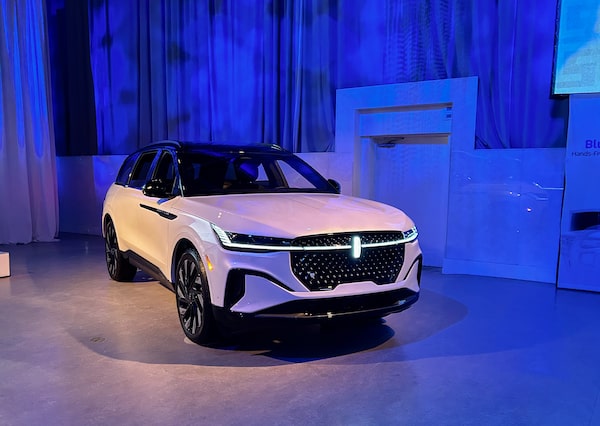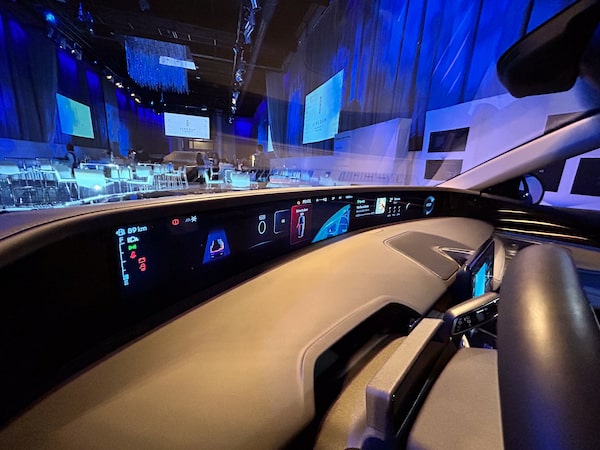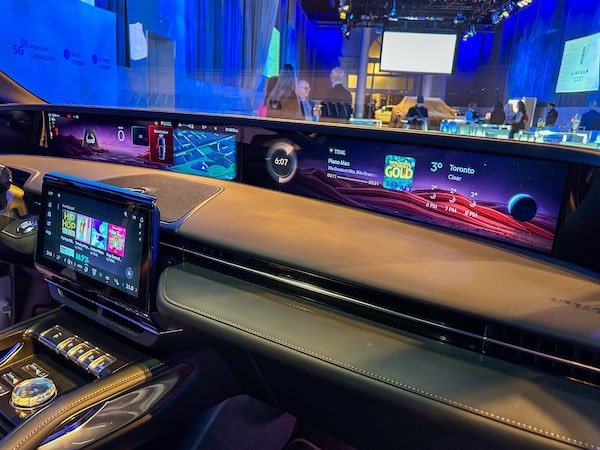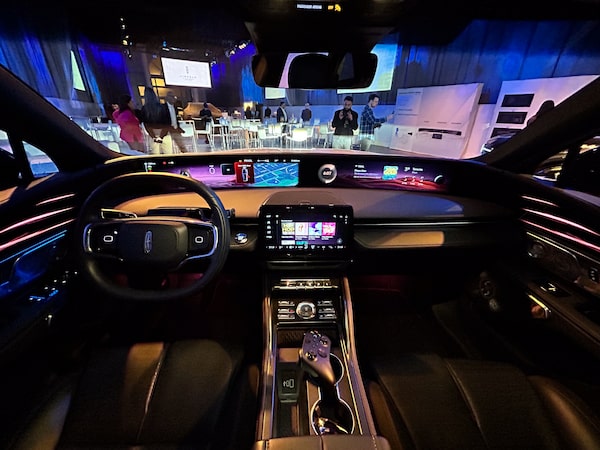
The redesigned Lincoln Nautilus, which will be the first with Ford's new in-vehicle experience.Kunal D'souza/The Globe and Mail
Vehicle interiors have transformed into digital playgrounds as new technologies roll out and ultra-fast 5G internet connections, cloud-based computing and artificial intelligence become commonplace. It wasn’t long ago that a five-inch screen would have been considered a luxury feature reserved for high-end cars, but LCD acreage comes cheap these days and we now see large screens in cars of all price ranges. It’s not just screens, it’s how we interact with the car through voice, touch and even gestures that’s changing rapidly.
Lincoln’s redesigned Nautilus SUV also gets a large 4K screen, but they’ve taken a novel approach by moving it up and farther from the driver, nestling it up against base of the windshield. It’s a thin strip that stretches 48-inches from A-pillar to A-pillar. It’s actually two 24-inch screens joined in the middle, but it’s done seamlessly.
“The intent with it is glanceable content while you’re driving,” says Craig LeMoyne, chief of in-vehicle experiences for Ford of Canada, at an event in Toronto. “When you’re navigating, you just kind of glance down and you can see what your next turn is versus having to look down at a screen, which is how it is in most cars today.”
It’s a departure from the direction some auto makers are heading in. I was recently in a new Mercedes-Benz EQE outfitted with their “Hyperscreen,” a 55-inch glass panel that stretches across the entire dash. It makes it feel like you’re on board a starship which is cool but that doesn’t exactly make it right for driving. There were too many reflections, too many fingerprints and it was, above all, distracting.

On the left is information critical to driving, while nice-to-know info is farther out of the field of view on the right.Kunal D'souza/The Globe and Mail
Touchscreens mounted in the centre of the dashboard near the climate controls have been the traditional way of doing things for the last 10-15 years as in-vehicle infotainment systems have gained prominence in the industry. BMW was one of the first to perch their screen on top of the dashboard and Toyota’s all-electric bZ4X has an instrument cluster that up high in the driver’s line of sight using the same principals as the screen in the Nautilus. But Lincoln has combined this into one continuous panel. “It’s actually less distracting because you don’t have to look down,” says LeMoyne. “And all the content you see, it’s not changing, it’s not overwhelming.”
The main display is controlled through a central touchscreen and it’s split into three sections. On the left is information critical to driving like speed, cruise control settings and fuel, just like on a traditional gauge cluster. In the middle there’s the navigation and to the right, farthest from the driver, are the configurable widgets like weather, clock or fuel efficiency data.
The system is based on the Android Automotive Operating System, which means that it’s customizable, updatable and fully integrated into the Google ecosystem with apps like YouTube, Google Maps and the Google Play store built in. You can also integrate Apple Carplay and Amazon Alexa and Lincoln says they can “deploy new apps very quickly and easily.”
The vehicle infotainment system is quickly becoming an extension of our smartphones. “If you want to know what the weather is, you just look here, you don’t have to look at your phone,” says LeMoyne. “We’re trying to make it so that people aren’t looking at their phones.”

Two 24-inch screens are joined seamlessly in the middle.Kunal D'souza/The Globe and Mail
There was a lot of Canadian talent involved with designing this system and, according to Lincoln, because it uses Android’s security framework your personal information remains safe and secure. You can block Google from accessing the in-vehicle microphones or limit access to your location, and it can be done on an app-by-app basis. And if you’re bored you can even play video games when parked by connecting a Playstation or Xbox controller using Bluetooth. After spending about 10 minutes with it I found the displays sharp, colourful and responsive. It’s also easy to use if you’re familiar with Android.
“There was a lot of work that went into imagining this panoramic display concept with glanceable content,” says LeMoyne. “It truly was re-imagining how we interface with the vehicle.”

The screens that run all the way across the dash on the redesigned Lincoln Nautilus are farther from the driver and designed to be less distracting.Kunal D'souza/The Globe and Mail
Shopping for a new car? Check out the Globe Drive Build and Price Tool to see the latest discounts, rebates and rates on new cars, trucks and SUVs. Click here to get your price.